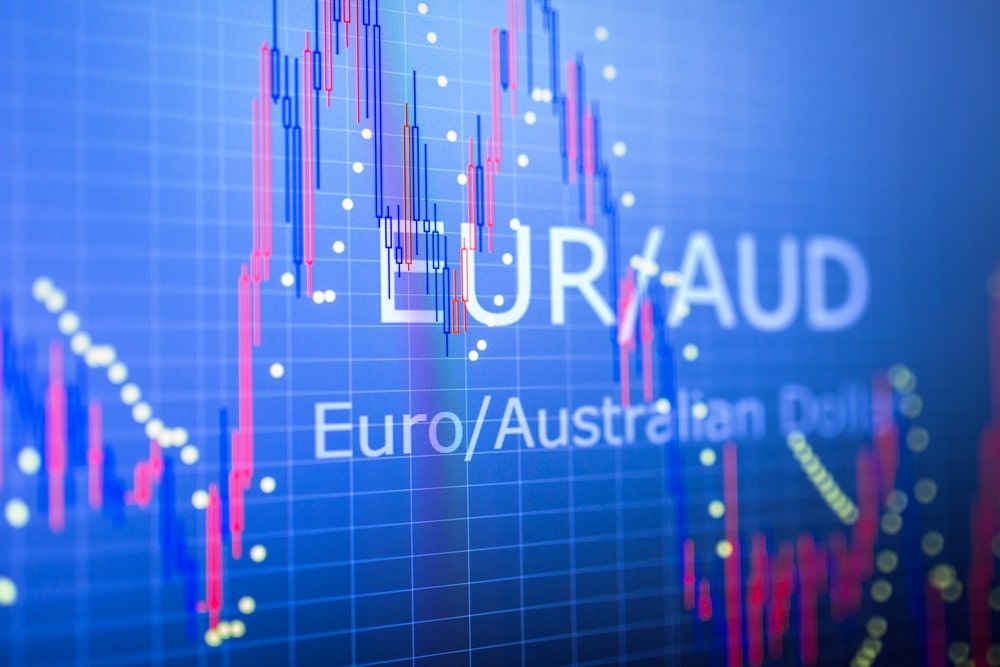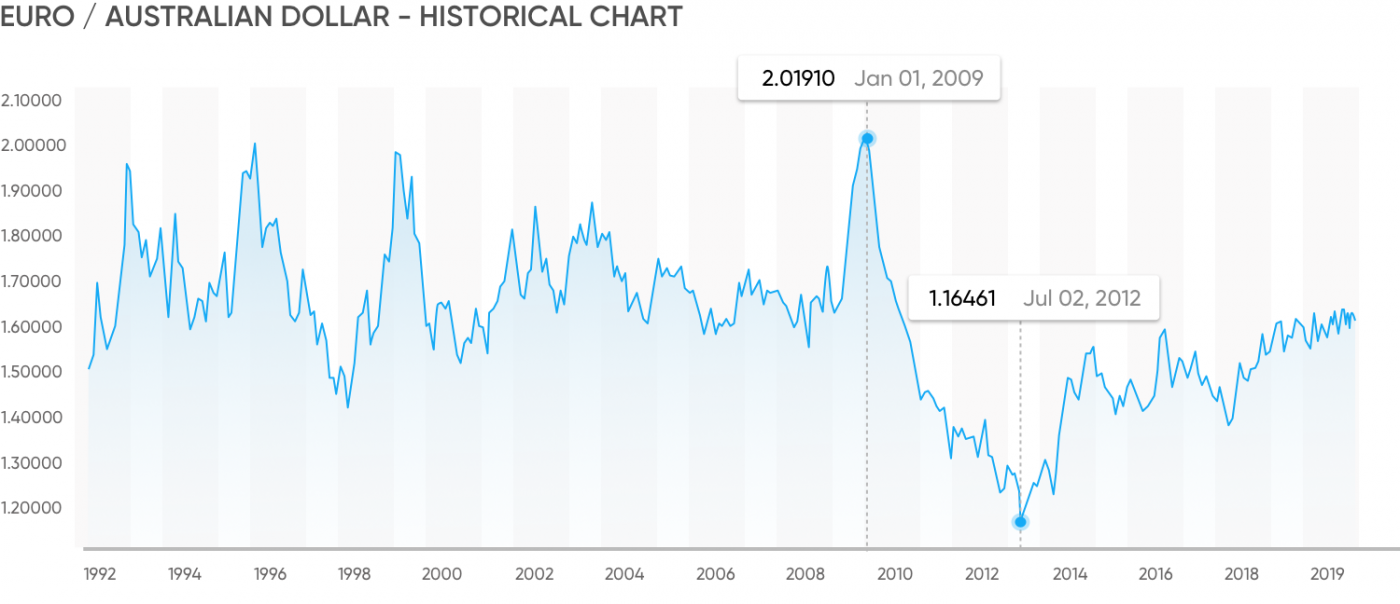Your guide to trading the EUR/AUD Forex pair

Why is the EUR/AUD an important market?
EUR/AUD is a commonly traded currency pair in the forex market. Learn what the euro to Australian dollar means for CFD traders and investors.
Trade [120]+ forex CFDs with Capital.com.
EUR/AUD trading hours
The foreign exchange market is open 24 hours a day, five days per week.
Trading activity for EUR/AUD tends to increase when the European and Australian markets are open – particularly around major European or Australian economic announcements, and when the Sydney and London trading sessions overlap.
History of EUR/AUD
Conceived in the latter half of the 20th century, the euro was first introduced as a digital currency in 1999, with physical notes and coins not released until 2002. Now the euro is the currency for over 20 European countries. Political and economic events since its launch, including the Eurozone debt crisis (2009–2012), have contributed to euro volatility.
The Australian dollar replaced the Australian pound in 1966, when Australia adopted the AUD as part of the country’s move to decimalisation. As the country has developed strong trading relationships with Asian economies, particularly China, trade flows have significantly influenced the AUD over the years.
Look below at the EUR/AUD price history (EUR/AUD conversion rate):

Past performance is not a reliable indicator of future results.
Factors influencing the EUR/AUD
As a forex currency pair, the EUR/AUD rate can react to various factors, including economic performance indicators and central bank policies – such as interest rate adjustments.
Role of EUR
The European Central Bank (ECB) releases regular reports and statements, typically published eight times per year, concerning rates and policy direction, which are used as indicators about possible future policy direction. Furthermore, many individual countries within the eurozone publish their own data, with Germany’s economy acting as a particularly influential indicator due to its size and role within the region.
Another factor that is considered is employment numbers, which are readily available to view. Consolidated employment figures for the region, along with other key indicators – such as inflation, GDP and economic sentiment – can impact the pairing.
Role of AUD
Many political and economic factors come into play when trading the Australian dollar. A particularly important point to look out for is the import and export industry of Australia. Historically, commodities exports – such as coal, iron ore, and a range of others – have influenced AUD’s value, which has fluctuated in line with global demand and commodity prices.
In Australia, the Reserve Bank of Australia (RBA) plays the central role in determining the value of the AUD at any given time. Additionally, Australian Government debt can affect the currency, alongside other factors, such as market sentiment and international capital flows.
How to trade EUR/AUD CFDs
You can speculate on the price movements of EUR/AUD either by trading contracts for difference (CFDs) on the currency pair, or by directly investing in the forex market.
CFD trading differs from traditional investing in that you do not own the underlying asset. A CFD is a financial contract between a broker and a trader, where the parties agree to exchange the difference in value of an underlying asset between the opening and closing of the contract. With CFDs, you do not take ownership of or receive delivery of the actual currency pair, enabling purely speculative trading.
You may open a long position (buy) if you expect the price of EUR/AUD to rise, or a short position (sell) if you anticipate the pair will fall in value.
Past performance is not a reliable indicator of future results
|
CFDs are complex instruments and carry a high risk of losing money rapidly due to leverage. A significant proportion of retail investor accounts lose money when trading CFDs. You should ensure you fully understand how CFDs work and carefully consider whether you can afford the risk of losing your money. |
Why trade EUR/AUD CFDs with Capital.com
Advanced technology – our news feed delivers curated content based on your interests; SmartFeed offers analysis and educational material to inform your decisions – recommending videos, articles, and news to help enhance your trading strategy.
Trade on margin – CFDs are traded on margin, with leverage of up to 20:1 for retail clients on non-major forex pairs such as EUR/AUD, subject to jurisdiction and regulatory status. Leverage beyond 1:1 magnifies both potential gains and potential losses.
Contracts for difference (CFDs) – by trading EUR/AUD CFDs, you speculate on whether its price will rise or fall. You can go short or long, set stop-loss and take-profit orders to manage risk, and apply trading scenarios that align with your objectives.*
Sharpen your analysis – stay informed about the latest moves with [100]+ technical indicators – including chart-drawing tools and more.
We prioritise your safety – Capital.com places strong emphasis on security. The platform operates entities authorised and regulated by the FCA, MENA, ASIC, SCB, and CySEC.
Rapid withdrawals – withdrawal requests can be submitted 24/7, and are processed within one business day. Client funds are held in segregated accounts in accordance with local regulations.
*Stop-loss orders aren’t guaranteed. Guaranteed stop-loss orders (GSLOs) incur a fee once activated.
Need more support? Try our step-by-step forex course to guide you through the basics to the advanced concepts.
FAQ
How is Forex different to other markets?
Forex operates without a central exchange. Trading is decentralised and conducted over the counter, involving a wide range of participants worldwide. This structure tends to result in high trading volumes and can offer competitive bid-ask spreads, potentially lowering trading costs compared to some other markets.
What is it that I'm buying and selling in Forex?
When you trade forex, you are speculating on the relative value between two currencies, rather than physically exchanging money. For instance, trading EUR/AUD involves taking a view on whether the euro will strengthen or weaken against the Australian dollar.
I keep seeing the word 'pip,' what does that mean?
A ‘pip’ is commonly understood as the smallest standard unit of price movement in the forex market, usually equal to 0.0001 for most major currency pairs.
Does Capital.com take commission from my Forex trades?
At Capital.com, there is no commission charged on forex CFD trades. Instead, trading costs are included in the spread – the difference between the bid and ask prices – along with any applicable overnight funding charges.